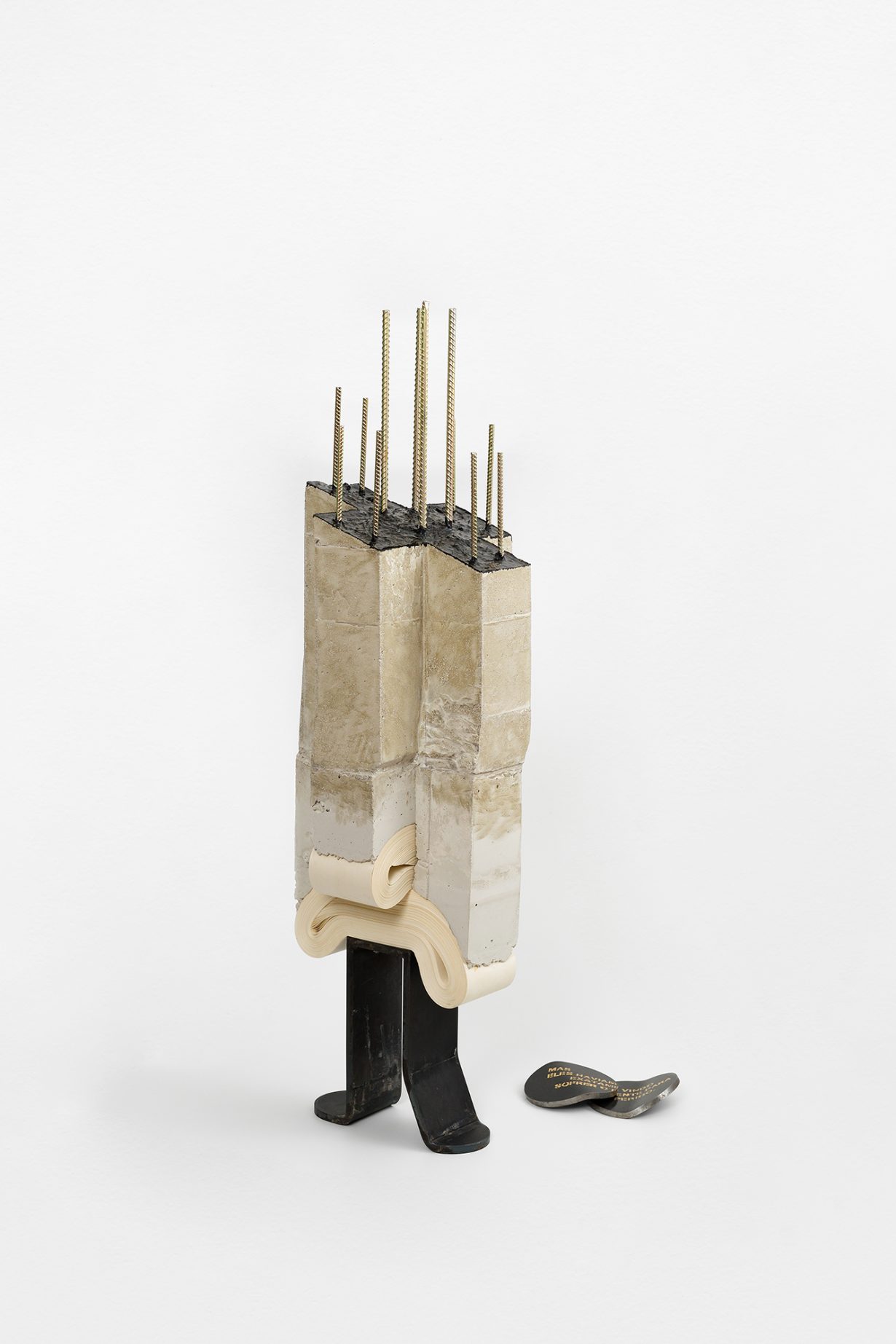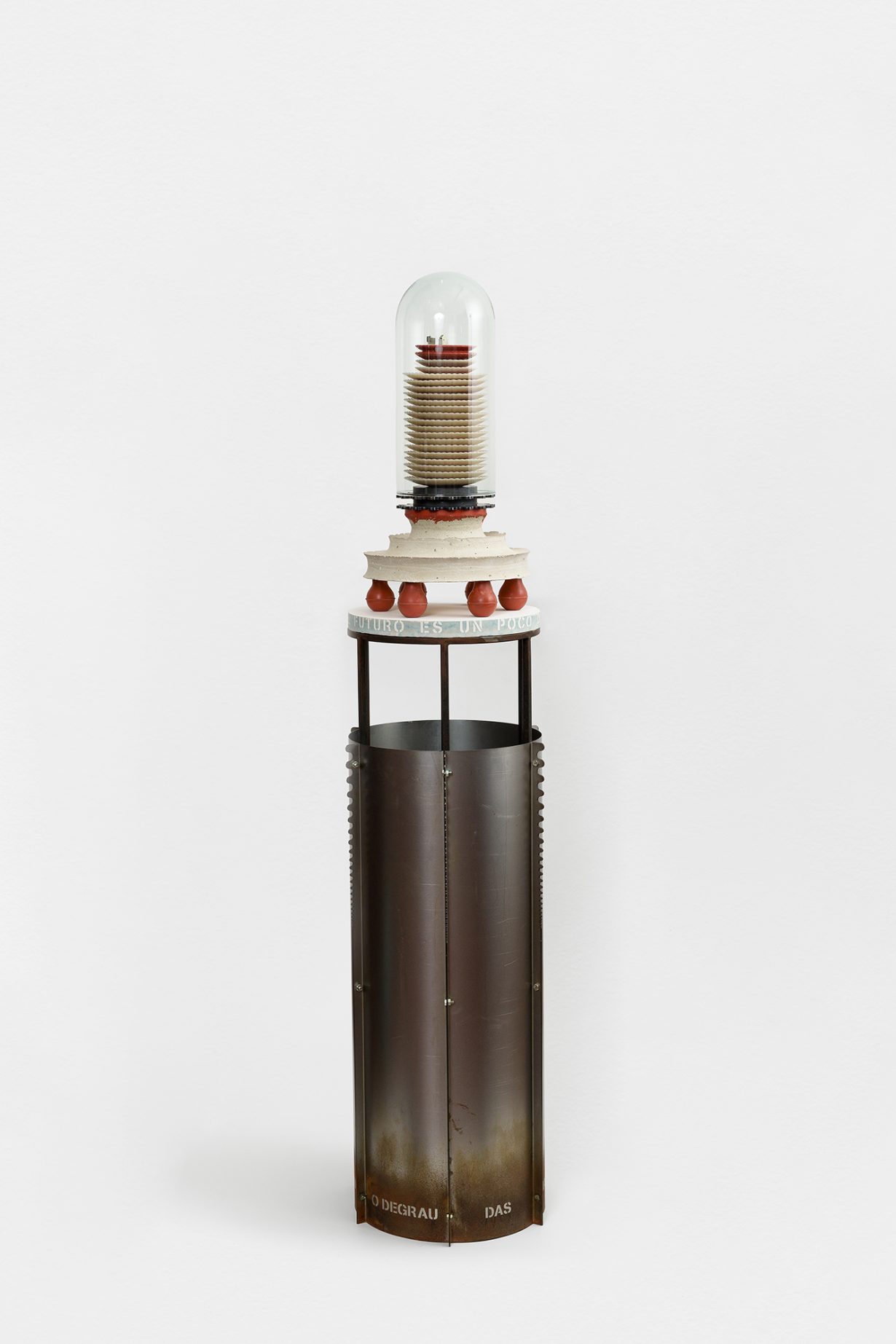In you text nothing like you look, the artist crafts a series of love letters to the authors and musicians who have inspired him
André Breton’s 1924 Surrealist Manifesto championed how ideas and images intermingle within a single subject, coexisting or curdling as they are processed through the eyes and into the brain – so it is apt that its centenary is being marked in the grand reception room of São Paulo’s largest public library, itself a great repository of literary images. Here, Lucas Simões has revisited a series of works he made between 2018 and 2021: (mostly) tall and upright sculptural assemblages of industrial materials, the majority presented on plinths. Though not explicitly figurative, they have a strangely anthropomorphic feel to them, their ‘personalities’ heightened by a series of literary quotes (two per sculpture, the lines quoted forming the extended titles of each work) newly engraved on the works, or included on metal floor plaques nearby. In this way, it is as if they have become avatars of authors ranging from Anne Sexton and Sylvia Plath to Jorge Luis Borges and Octavio Paz; a small army of references amalgamating like books on a shelf, or as influences on a reader.

One work features a metre-high circular chimney of sheet metal, on top of which are placed two cast-plaster discs, separated by silicone balls. Above these is a metal cog that serves as the base for a stack of ceramic dessert plates, the resulting tower of objects enclosed by a tall bell jar. The edge of one plaster element bears a line from Paz’s poem ‘Trowbridge Street’ (c. 1969–75), in the original Spanish: ‘El futuro es un poco de agua en tus ojos’ (‘The future is a drop of water in your eyes’). Etched around the base of the steel chimney is a second line, from the Portuguese poet Al Berto: ‘O mar subiu o [sic] degrau das manhãs idosas’ (‘The sea rose to the step of the elderly mornings’). Connected by intimations of time and the proximity of water, these quotes live together in the sculpture, a portrait, perhaps, of their influence on Simões. A second work, a sort of clouded-glass lighthouse beacon mounted on a concrete block, features lines of obsession by the Briton Sylvia Plath and the Argentine Alejandra Pizarnik (‘No day is safe from news of you’, from the former’s 1962 poem ‘The Rival’). Simões brings influences from beyond literature too: an oval concrete sculpture, with a copper-gilded Barbara Hepworth-ish hole, balancing on a steel block, contains lines on time by American Broadway composer Lorenz Hart and the Brazilian writer Raduan Nassar; Björk and Italian novelist Cesare Pavese find their work featured on black steel-framed sculpture, the titular lyric from the Icelandic singer’s History of Touches (2015) etched on a curled reel of metal that extends from the base.

If the exhibition reads as love letters to the authors and musicians who have inspired Simões, they also become something of a self-portrait, an exquisite corpse of literary references. The artist’s viewer receives the lines authored by these famous names but mediated by Simões, linking the disparate writers as he has done, connections of the kind we all make whenever we read a book or listen to a piece of music. Simões’s ongoing inspiration has been the urban realm, born of walking Brazil’s metropolises – a world of concrete and industrial metals – while maintaining a latent sensuality. It is that sensing – the sense where the subject meets the world around it, the exchange that lay at the heart of Breton’s project too, that is heightened in this elegant, cerebral exhibition.
you text nothing like you look at Biblioteca Mário de Andrade, São Paulo, through 2 February
From the January & February 2025 issue of ArtReview – get your copy.
